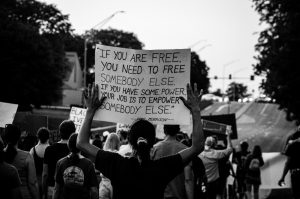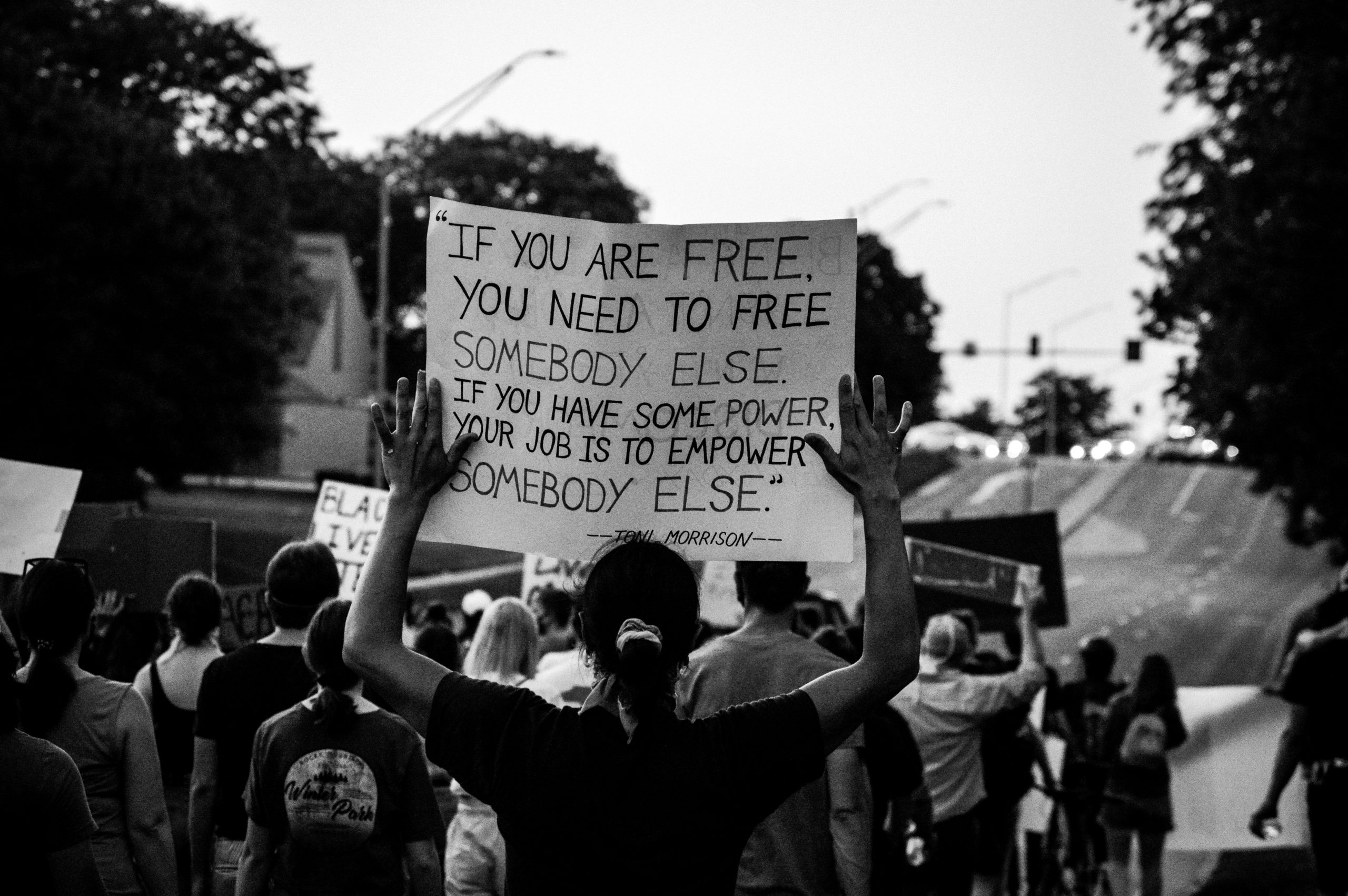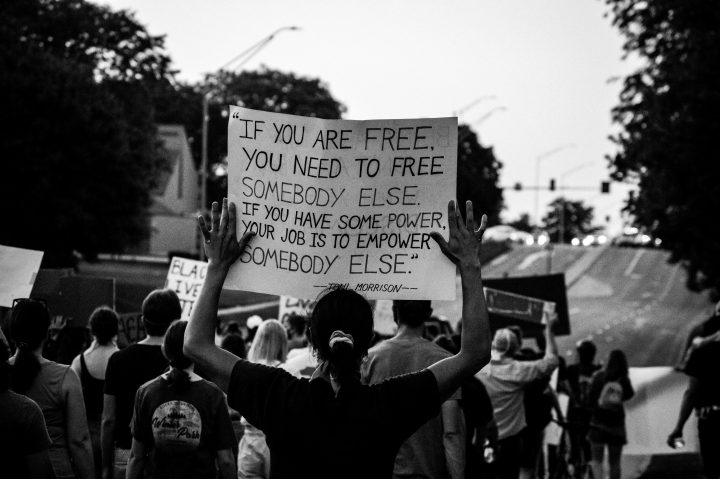“We have more data and technology than ever in our daily lives and more social, political and economic inequality and injustice to go with it”.
(Noble 2018, p.171)
OUR DIGITAL WORLD, FRACTURED AND POLARISED
There is ample evidence of the contribution of new technologies to the reproduction and amplification of the cruel racist, sexist and classist system that rules our world. Of course, the code behind these technologies is created by humans and our imperialist white supremacist capitalist patriarchy, as Bell Hooks calls it, so what could we expect?
“But, you know, it’s really difficult for people to zoom the lens out, and think in a more patterned, systematic way. I think once we do, however, it becomes much easier to understand how technology is part of the pattern. It’s one of the mechanisms, in addition to laws, in addition to economic policies, in addition to, let’s say, redlining, housing-discrimination policies, to see that technology is one of the facets that we have to take into consideration. But, as you say, a very simplistic understanding of what racism is prevents that jump in many ways.”
We are already living in the age of the Metaverse and many talk already about how this new technological evolution will impact all areas of our (very) near future. Although I do not perceive around me a great social resistance to live our lives mostly in virtual mode, I do personally find it disturbing enough to have read at least a few thoughts of the numerous experts who warn of its dangers. Louis Rosenberg, convinced that this next decade will be vital for augmented reality to become central to all aspects of our lives, admits to fearing the fractured society that the Metaverse could mean.
“The virtual overlays could easily be designed to amplify political division, ostracize certain groups, even drive hatred and mistrust. Will this really make the world a better place? Or will it take the polarized and confrontational culture that has emerged online and spray it across the real world?”
There is no need to theorise about the future, since components of this metaverse such as augmented reality, virtual reality or social media have already been showing us for decades their power to exacerbate our racist, sexist and classist systems and the multiple kinds of oppressions that come from them. A phenomenon that has been studied and written about extensively and from many different perspectives, but which does not seem to be improving, if not quite the opposite. Lisa Nakamura (2020) for example, analyses the most recent advances in Virtual Reality technology applied to the documentary genre and explains the toxic racial empathy that it automates. She argues that the believe that VR connects people across difference is just a branding strategy “part and parcel of Big Tech’s attempt to rebrand VR as a curative for the digital industries’ recently scrutinized contributions to exacerbating class inequality, violating users’ privacy, and amplifying far right fascist racism and sexism” (p.48). Contrary to this, Nakamura explains how VR documentary automates a kind of empathy that provides the Western audience with an opportunity to enjoy sites of suffering while leaving structural racism in place. This technology that promises to be part of the solution is for her just a “cultural alibi for a digital media culture that has taken a wrong turn, towards distraction, detachment, and misinformation” (p.49), serving as a modern way of identity tourism, offering the user stigmatized “exotic, racialized and gendered avatars” for temporary recreation (p.54). In this same work, Nakamura claims that “the early internet was part of an era of idealism, enthusiasm and above all license for the digital industries” (p.49), and this was the case too for the penetration of social media into Western societies, accompanied by a great enthusiasm and a narrative positioning them as platforms that could empower and give voice to the most marginalized communities and oppressed collectives. This narrative, while not entirely untrue, ignores all aspects of the Global Digital Divide and the incredible divisive power of these new media.
Social media have been fracturing our societies for years. Although we can still somehow “escape” them and have a number of, as Rosenberg describes them, “authentic real-world experiences, face-to-face, that aren’t filtered through corporate databases or manipulated by intelligent algorithms” (which the Metaverse we are heading towards seems likely to make even more difficult), these digital platforms are already fundamental to our existence in the Global North and beyond. The ITU recently revealed that 63% of the world population (4.9 billion people) is using the Internet in 2021. Out of the 2.9 billion people still offline, the 96% live in developing countries. According to a recent analysis by Kepios there are 4.55 billion social media users around the world, which means that 9 out of 10 internet users are on social media. Numbers keep rising as it does the level of dependence towards these platforms, even as we become increasingly aware of how they polarize our political opinions, reinforce extremist behaviors and increase social inequalities. To understand how these inequalities are amplified through these platforms we must understand that the algorithms through which they operate are a reflection of our world system of unequal power relations.
WHO RUNS THE WORLD? ALGORITHMS!
In her book “Algorithms of Oppression”, Safiya Umoja Noble (2018) explains how algorithms behind platforms like Google determine what we see or read in ways that reinforce systemic racism and sexism. Noble asserts that “we are only beginning to understand the long-term consequences of these decision-making tools in both masking and deepening social inequality” (p.1) and that “news instances of racism keep appearing in social media” (p.10). The truth is that “Whiteness is a default standard” (Bell, 2004; Sue, 2015, cited by Sue 2017, p.707) and the algorithms that dominate our world today reflect this. Many examples of these racist algorithms have made headlines in recent years, such as the case of No White Saviors or that of Missing and Murdered Indigenous Women and Girls (MMIWG) who denounced having been victims of shadow banning, a term that defines the practice of deleting or making posts invisible on social media. There are many cases like this one, in which activists even denounce that Instagram’s algorithms protect White supremacists while deleting content from those who actually work to make them accountable. The same type of denunciations have been received by other social networks such as LinkedIn, accused of censoring anti-racist comments, or TikTok, accused of anti-blackness and of being governed by algorithms that make it difficult for non-White content creators to publish and make their videos visible, while the same content created by Whites is not subject to any restrictions.
“Algorithms are, and will continue to be, contextually relevant and loaded with power”
(Noble 2018, p.171)
ANTI-RACIST ACTIVISM IN RACIST PLAFTORMS – IS THERE SUCH A THING AS WHITE ANTI-RACISTS?
Nevertheless, “in many ways, social media have become requisite platforms for race-related activism” (Engles 2017, p.92), key working tools for activists, loaded with content aimed at educating about anti-racism. However, they also mediate and reinforce many of the racist behaviors that shape our offline society and that now find new ways to perpetuate themselves online. In my research for this post I found noteworthy the study, based on the concept of “respectability politics”, by Pitcan, Marwick and Boyd (2018) on how young people from lower socioeconomic classes in New York represented a much-studied version of themselves in their online lives, “a vanilla self”. Respectability politics refers to a strategy of representation of “marginalized individuals meant to depict them as sharing similar traits, values, and morals that align with the dominant group’s definition of respectability” (Studio ATAO, 2021). In this study on how digital media mediate the intersection of class, gender and race, the authors demonstrated that conditioned by their social class and status, and in order to succeed in their personal and professional lives, the studied subjects seek to reproduce online behaviors that adhere to the normative notion of respectability, a “neoliberal, White, bourgeois normativity”(p.166). They conclude that social media reflected and extended the offline dynamics characteristic of this strategy thus reinforcing structural inequality by privileging racist, sexist, and classist values as the respectable ones.
What I found the most interesting about this reading was precisely to realize once again that from my privileged position as a white, middle-class European, I have never noticed these patterns of behavior in my online world. This brings to my mind Sue’s (2017) words in her article “The Challenges of Becoming a White Ally”, when she introduces the analogy of the airport conveyor belt that Tatum used to explain the cycle of racism.
“Passive racist behavior is equivalent to standing still on the walkway. No overt effort is being made, but the conveyor belt moves the bystanders along to the same destination as those who are actively walking. Some of the bystanders may feel the motion of the conveyor belt, see the active racists ahead of them, and choose to turn around, unwilling to go to the same destination as the White supremacists. But unless they are walking actively in the opposite direction at a speed faster than the conveyor belt—unless they are actively antiracist—they will find themselves carried along with the others” (Tatum 1997, p. 11–12, cited by Sue 2017, p.706-707).
Sue goes on to argue that biased institutional policies and practices and power structures operate in our everyday lives in unconscious ways, permeating us and normalising racist attitudes and beliefs, pulling people on the conveyor belt towards notions of white supremacy (p. 707). She asserts that “because of socialization practices and cultural conditioning, the movement is barely noticed by most White” (p.707).
I have previously used this blog to reflect on hashtag activism and related terms, as well as on the role that White social media users take, can and should take to support BIPOC movements in ways that positively impact the quest for greater equality and social justice. “White involvement in racial justice movements through publicly mediated critical racial discourse dates back to 1831, when William Lloyd Garrison’s Liberator newspaper called for the immediate end of slavery” (Baszile, 2015, cited by Clarck 2019, p.520). From then until our current digital world, many have written about the importance of members of both dominant and oppressed groups joining forces and cooperating in social movements that address social and racial injustice. Standing still on the conveyor belt or not walking fast enough in the opposite direction is not an option for me, but how can White people engage in truly beneficial digital allyship? How do they effectively use digital media to amplify the actions and messages of those they seek to be allies for? I don’t have clear answers, but I would like to end this post by sharing some ideas that in my reading on the subject I have found particularly revealing.
According to McClanahan (2021) and her study on performative activism and slacktivism under the frame of the #BlackLivesMatter movement, the big mistakes committed by white people when supporting BIPOC causes in the context of race-related activism are “virtue signaling, misusing common phrases and terminology surrounding racial issues in a way that reaffirms notions of white supremacy and privilege, and policing the tone of their BIPOC counterparts or refusing to acknowledge BIPOC as agents of change within their own lives” (p. 16). Also in the #BLM context, although not focusing on online activism, Erin.B Logan claims that White people’s motivation to protest is more abstract and less urgent, not responding to the sense of “intolerable and immediate injustice” Black people feel. Logan argues that is very difficult for White protesters to really comprehend how Black people suffer from systemic racism, that their involvement is fleeting and driven by their quest for recognition, and that it overshadows the actions and courage of black activists. I previously mention too in this blog “The White Anti-Racist is an Oxymoron: An Open Letter to ‘White Anti-Racists’” by Kim Ja Kil, which comes to say that Whiteness itself is an artifact of racism and therefore claiming to be a “White anti-racist” is not possible since the only way out of racism is to destroy White identity collectively. Engles makes reference to it in “Racialized Slacktivism: Social Media Performances of White Antiracism”:
“As a white scholar, I hesitate to even ask such questions since, as Ahmed points out, white people too often ask nonwhite scholars and activists such as herself, “What can white people do?” Ahmed continues, “The sheer solipsism of this response must be challenged,” because to ask such a question “is not only to return to the place of the white subject, but it is also to locate agency in this place. It is also to reposition the white subject as somewhere other than implicated in the critique” (“A Phenomenology” 164–65) Ahmed nearly affirms Kil Ja Kim’s claim, that “the white anti-racist is an oxymoron,” and perhaps all I should do in closing, despite my conviction as a scholar and educator that knowledge can be a form of power, is acknowledge that Kim may well be right and that white people should simplymstop trying to fight racism, including talking and writing about it” (Engles 2017, p.105).
In this essay Engles argues that social media interaction often “tends to inspire impulsive, shallow, and solipsistic modes of self-aggrandizing display, steering aspiring white allies all that much more strongly toward “slacktivism,” rather than to effective activism” (p.93). However, he closes the essay with a reference to Barbara Appleubaum’s statement on the actually effective white antiracism action that is to remain vigilant on the effects of one’s privileged racial positionality and acting accordingly (p. 105). For others who do believe that White allyship exist beyond performance, it is considered a constant lifelong journey which requires developing authentic relationships with people of color (Sue 2017, p.709), offering them support (not judgement) and active listening (Campbell cited by McClanahan 2021, p.17).
“Not staying silent on issues of racism, studying anti-racist literature, learning about systemic racism through currently unjust policies, removing people from your life who are uncomfortable with your allyship, unlearning your own racist tendencies and behaviors, giving up positions that reaffirm your white privilege, and encouraging BIPOC to take up space as they see fit. By employing these strategies as a means of addressing the downfalls associated with white allyship, white allies could move from a state of performative allyship to action-oriented allyship.”
( Boutte and Jackson cited by McClanahan 2021, p.18)

A FAREWALL NOTE
Technology continues to take over all areas of our reality, deepening social differences, privilege and oppression, the affluence of some and the poverty of others. Yet there are more than a few who struggle to put this technology at the service of a better future. What will our world be like in 10 or 50 years’ time? What can I do to make it a little better? I wondered while writing for Decolonline.
The opportunity to write for readers who may share with me a biased view of the world and a certain cultural background, has helped me to feel freer when writing, as I accepted the condition from which I write and simply tried to share my doubts about issues that seem to me crucial to understand the world we inhabit, highlighting what I found the most inspiring readings. This has been a great exercise in self-reflection for me. I know that I am so comfortable in my privileges that I sometimes choose to be oblivious to them. This blog has brought me enriching exchanges of views and lessons, it has helped me in the crucial exercise of developing the capacity to be more aware of how my privileges can interfere with my work as a communicator within the field of Development, and how they can negatively impact on others who I intend to benefit from my work.
It only remains for me to say thank you to you who are reading this and hope that Decolonline has provided you with this opportunity for reflection as well.
–
BIBLIOGRAPHY:
Asare, J. G. (2021, January 9). Social Media Continues To Amplify White Supremacy And Suppress Anti-Racism. Forbes. Retrieved November 2021 from https://www.forbes.com/sites/janicegassam/2021/01/08/social-media-continues-to-amplify-white-supremacy-and-suppress-anti-racism/?sh=415a19964170
Clark, M. D. (2019). White folks’ work: digital allyship praxis in the #BlackLivesMatter movement. Social Movement Studies, 18(5), 519–534. https://doi.org/10.1080/14742837.2019.1603104
Engles, T. (2017). Racialized Slacktivism: Social Media Performances of White Antiracism. In T. M. Kennedy, J. I. Middleton, & K. Ratcliffe (Reds.), Rhetorics of Whiteness: Postracial Hauntings in Popular Culture, Social Media, and Education (1st ed., pp. 92–111). Southern Illinois University Press. http://works.bepress.com/tim_engles/30/
Facts and figures 2021. (2021). International Telecommunication Union (ITU). Retrieved December 2021, from https://www.itu.int/itu-d/reports/statistics/facts-figures-2021/
Garcia, S. E. (2020, 17 juni). BIPOC: What Does It Mean? The New York Times. Retrieved December 2021, from https://www.nytimes.com/article/what-is-bipoc.html
Global Social Media Stats. (2021). DataReportal – Global Digital Insights. Retrieved December 2021, from https://datareportal.com/social-media-users
Jackson, J. (2019, August 16). “Black Communities Are Already Living in a Tech Dystopia”. FAIR. Retrieved November 2021, from https://fair.org/home/black-communities-are-already-living-in-a-tech-dystopia/
Lim, M., & Alrasheed, G. (2021, May 16). Beyond a technical bug: Biased algorithms and moderation are censoring activists on social media. The Conversation. Retrieved November 2021, from https://theconversation.com/beyond-a-technical-bug-biased-algorithms-and-moderation-are-censoring-activists-on-social-media-160669
Logan, E. B. (2020, September 8). How white people gentrified Black Lives Matter. Los Angeles Times. Retrieved November 2021, from https://www.latimes.com/opinion/story/2020-09-04/black-lives-matter-white-people-portland-protests-nfl
McClanahan. A. (2021) The Downfalls of Performative White Allyship on Social Media in the #BlackLivesMatter Movement. Munn Scholars Awards. 7. Retrieved November 2021, from https://researchrepository.wvu.edu/munn/7/
Molina, M. U. S. A. B. T. (2021, 15 november). Everyone wants to own the metaverse including Facebook and Microsoft. But what exactly is it? USA TODAY. Retrieved November 2021, from https://eu.usatoday.com/story/tech/2021/11/10/metaverse-what-is-it-explained-facebook-microsoft-meta-vr/6337635001/
Nakamura, L. (2020). Feeling good about feeling bad: virtuous virtual reality and the automation of racial empathy. Journal of Visual Culture, 19(1), 47–64. https://doi.org/10.1177/1470412920906259
Noble, S. U. (2018). Algorithms of Oppression: How Search Engines Reinforce Racism (Illustrated ed.) [E-book]. NYU Press.
Pitcan, M., Marwick, A. E., & Boyd, D. (2018). Performing a Vanilla Self: Respectability Politics, Social Class, and the Digital World. Journal of Computer-Mediated Communication, 23(3), 163–179. https://doi.org/10.1093/jcmc/zmy008
Rosenberg, L. (2021, November 6). Metaverse: Augmented reality inventor warns it could be far worse than social media. Big Think. Retrieved November 2021, van https://bigthink.com/the-future/metaverse-augmented-reality-danger/
Rosenblatt, K. (2021, February 13). Months after TikTok apologized to Black creators, many say little has changed. NBC News. Retrieved November 2021, from https://www.nbcnews.com/pop-culture/pop-culture-news/months-after-tiktok-apologized-black-creators-many-say-little-has-n1256726
Studio ATAO. (2021, 11 mei). Understanding Respectability Politics. Retrieved December 2021, from https://www.studioatao.org/post/understanding-respectability-politics
Sue, D. W. (2017). The Challenges of Becoming a White Ally. The Counseling Psychologist, 45(5), 706–716. https://doi.org/10.1177/0011000017719323


